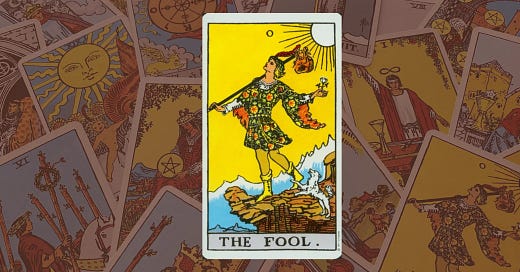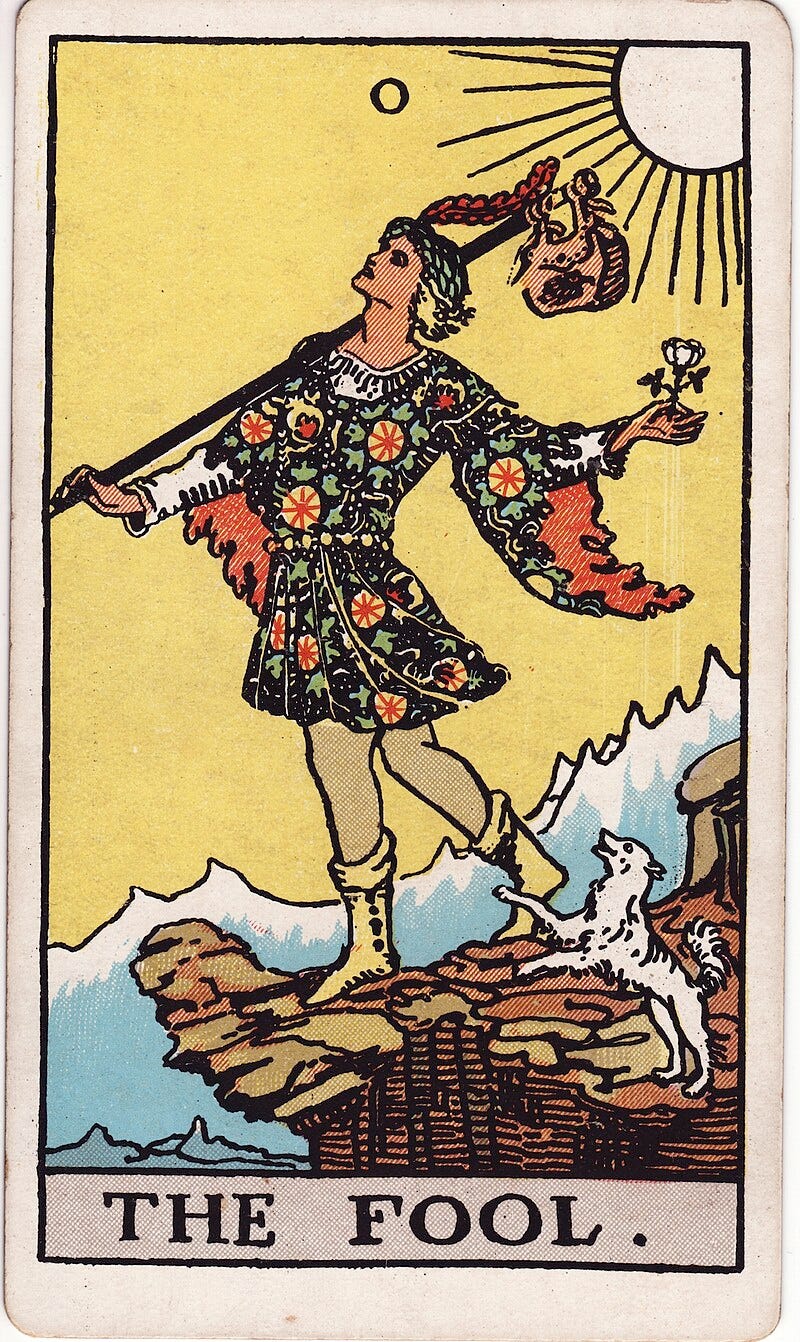About to walk off a cliff? Yes, this guy seems to be a fool.
But in the Marseilles tarot, this foolishness is less perilous:
Which gets you thinking: are fools always foolish? According to St. Paul, some fools are wise:
“If any man among you seems to be wise in this world, let him become a fool, that he may be wise” (1 Cor 3.18)
The rest of the Fool’s iconography across the Tarot is similar: a jester's hat, a bindle slung over his back, a yapping dog. He is a jester or perhaps a bard, reminiscent of the Joker. He is homeless, itinerant, free.
As arcanum 0, he is also the beginner, the hero prior to the call. We are thus all the Fool. In the earliest tarot, he is dressed in rags. The Fool is a beggar, as we all are before God.
Crowley, ever the Qabbalist, associated this 0 with the first letter of the Hebrew alphabet – ‘aleph – the glottal stop, a non-letter. It is the space between sounds, a wanderer among words. For those that see the arcana as representing the journey through life, the zero is the hero of the story who, by card 21, has conquered “the World.”
Waite gives reasons for the Fool’s foolishness: “Folly, mania, extravagance, intoxication, delirium, frenzy, bewrayment.” And so the Fool walks off a cliff because he has lost his mind. If he falls to his death, we will say of course. If – having taken the leap to faith – he ascends to heaven, we will say praise God.
This is duality of the Fool: just as the Magician is also a Charlatan, so the Fool is also the Sage.
Crowley saw the Fool (0) as the Magician (1) not yet come of age. But how is that that 0 becomes 1? How does something come from nothing? The key may be exactly the leap. Kierkegaard would like that.
For Tomberg, the Fool is Don Quixote, who was both El Loco and El Bueno. We see him everywhere (Orpheus, Gilgamesh, Parzival, Hamlet, Faust) because “the Arcana of the Tarot are more than symbols and even more than spiritual exercises: “they are magical entities, active initiating archetypes.” He goes on:
“The Fool has a double meaning . . . as a model and as a warning at the same time. For on the one hand it teaches the freedom of transcendental consciousness elevated above the things of the world, and on the other hand it clearly presents a very impressive warning of the peril that this elevation comprises – lack of concern, inadequacy, irresponsibility and ridicule . . . in a word, madness.”
This explains the dog. The Fool could easily hit the dog, but this would be cruel. But if the dog is rabid and about to bite him, such “lack of concern” would indeed be “madness.” The Fool walks a perilous road.
One last thing: the Fool dresses in motley. He does not wear the dress of any particular group, rank, or sect. He is “the Fool” unencumbered by identity. He is anatta, no self. He is card 0. He is all of us before ego.
Further reading
Weird Religion:
Aleister Crowley, The Book of Thoth
Valentin Tomberg, Meditations on the Tarot
A.E. Waite, The Pictorial Key to the Tarot
Weird Studies, “What a Fool Believes”






